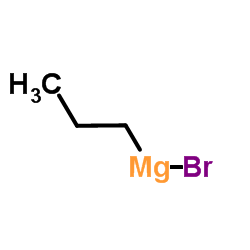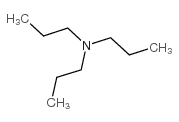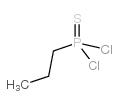15573-31-6
| 中文名 | 二氯丙基磷 |
|---|---|
| 英文名 | 3,3-dichloropropylphosphane |
| 英文别名 |
MFCD00013618
Dichlor-propyl-phosphin propylphosphonous acid dichloride Propyldichlorophosphine n-propyldichlorophosphine dichloro-n-propyl phosphine |
| 密度 | 1.11 |
|---|---|
| 沸点 | 133ºC |
| 熔点 | 135-136℃ |
| 分子式 | C3H7Cl2P |
| 分子量 | 144.96700 |
| 闪点 | 36.8ºC |
| 精确质量 | 143.96600 |
| PSA | 13.59000 |
| LogP | 3.18590 |
| 外观性状 | Liquid | Colorless to pale yellow |
| 蒸汽压 | 8.79mmHg at 25°C |
| 储存条件 | 常温密闭避光,通风干燥惰性气体下 |
| 稳定性 | 常温常压下稳定 避免的物料:水分/潮湿 氧化物 碱 |
| 计算化学 | 1.疏水参数计算参考值(XlogP):1.6 2.氢键供体数量:0 3.氢键受体数量:0 4.可旋转化学键数量:2 5.互变异构体数量:无 6.拓扑分子极性表面积0 7.重原子数量:6 8.表面电荷:0 9.复杂度:30 10.同位素原子数量:0 11.确定原子立构中心数量:0 12.不确定原子立构中心数量:0 13.确定化学键立构中心数量:0 14.不确定化学键立构中心数量:0 15.共价键单元数量:1 |
|
Section 1: Product Identification Chemical Name:n-Propyldichlorophosphine, min. 98% CAS Registry Number:15573-31-6 Formula:n-C3H7PCl2 EINECS Number:none Chemical Family:organophosphine halide Synonym:Dichloropropylphosphine, Phosphine, dichloropropyl-
Section 2: Composition and Information on Ingredients IngredientCAS NumberPercentACGIH (TWA)OSHA (PEL) Title Compound15573-31-6100%no datano data Section 3: Hazards Identification Material has a pungent odor. Inhalation of vapor may cause coughing, headache, and pulmonary edema. Very Emergency Overview: corrosive to eyes, skin, nose, and mucous membranes. Primary Routes of Exposure:Contact with skin and eyes. Inhalation of vapor. Eye Contact:Causes burns to the eyes. Causes mild to severe irritation of the skin. Hydrochloric acid hydrolysis product is a corrosive liquid or vapor. Skin Contact: Inhalation:Corrosive Inhalation may cause spasms, coughing, chemical pneumonitis and pulmonary edema. Ingestion:Corrosive to mouth throat and stomach. May cause dizziness, nausea, vomiting, pain and stomach upset. Material has a pungent odor. Inhalation of vapor may cause chemical pneumonitis and pulmonary edema. Acute Health Affects: Contact of liquid or vapor with eyes and skin causes burns. Chronic Health Affects:No information available on long-term chronic effects. NTP:No IARC:No OSHA:No SECTION 4: First Aid Measures Immediately flush the eyes with copious amounts of water for at least 10-15 minutes. A victim may need Eye Exposure: assistance in keeping their eye lids open. Get immediate medical attention. Wash the affected area with water. Remove contaminated clothes if necessary. Seek medical assistance if Skin Exposure: irritation persists. Remove the victim to fresh air. Closely monitor the victim for signs of respiratory problems, such as difficulty Inhalation: in breathing, coughing, wheezing, or pain. In such cases seek immediate medical assistance. Seek medical attention immediately. Keep the victim calm. Give the victim water (only if conscious). Induce Ingestion: vomiting only if directed by medical personnel. SECTION 5: Fire Fighting Measures Flash Point:no data Autoignition Temperature:no data Explosion Limits:no data Extinguishing Medium:carbon dioxide, dry powder or foam If this material is involved in a fire, fire fighters should be equipped with a NIOSH approved positive pressure Special Fire Fighting Procedures: self-contained breathing apparatus and full protective clothing. Hazardous Combustion andIn a fire material may emit toxic organic fumes, carbon monoxide, carbon dioxide, and phosphorous pentoxide. Decomposion Products: Unusual Fire or Explosion Hazards: No unusual fire or explosion hazards. SECTION 6: Accidental Release Measures Small spills can be neutralized with powdered sodium bicarbonate, lime, or calcium carbonate and swept up. Spill and Leak Procedures:Spillage in areas not adequately ventilated will require an evacuation of site. Emergency response teams will require self-contained breathing apparatus. SECTION 7: Handling and Storage Store in a cool, dry, well-ventilated area. Keep containers tightly sealed. Transfer material under an inert Handling and Storage: atmosphere of nitrogen or argon. SECTION 8: Exposure Controls and Personal Protection Always wear safety glasses. If pouring or transferring this substance wear a face shield for additional Eye Protection: protection. Skin Protection:Wear protective clothing and gloves. Consult with glove manufacturer to determine the proper type of glove. Ventilation:Material has a pungent odor. Always handle material in an efficient fume hood. If ventilation is not available a respirator should be worn. The use of respirators requires a Respirator Respirator: Protection Program to be in compliance with 29 CFR 1910.134. Ventilation:Material has a pungent odor. Always handle material in an efficient fume hood. Additional Protection:No additional protection required. SECTION 9: Physical and Chemical Properties Color and Form:colorless liq. Molecular Weight:144.97 Melting Point:no data Boiling Point:133°C Vapor Pressure:no data Specific Gravity:1.118 Odor:sharp acidic odor Solubility in Water:Reacts vigorously with water SECTION 10: Stability and Reactivity Stability:air sensitive, moisture sensitive Hazardous Polymerization:no hazardous polymerization Conditions to Avoid:contact with air or moisture Incompatibility:Water, air, oxidizing agents, active metals, oxygen and sulfur Decomposition Products:carbon dioxide, carbon monoxide, phosphorus oxide, hydrogen chloride, and organic fumes SECTION 11: Toxicological Information RTECS Data:No information available in the RTECS files. Carcinogenic Effects:No data available Mutagenic Effects:No data available Tetratogenic Effects:No data available SECTION 12: Ecological Information Ecological Information:No information available SECTION 13: Disposal Considerations Disposal:Dispose of according to local, state and federal regulations. SECTION 14: Transportation Shipping Name (CFR):Corrosive liquids, N.O.S. Hazard Class (CFR):8 Additional Hazard Class (CFR):NA Packaging Group (CFR):I UN ID Number (CFR):UN# 1760 Shipping Name (IATA):Corrosive liquid, N.O.S. Hazard Class (IATA):8 Additional Hazard Class (IATA):NA Packaging Group (IATA):I UN ID Number (IATA):UN# 1760 SECTION 15: Regulatory Information TSCA:Not listed in the TSCA inventory. SARA (Title 313):Title compound not listed. Second Ingredient:none SECTION 16 - ADDITIONAL INFORMATION N/A |
|
生态学数据: 通常对水体是稍微有害的,不要将未稀释或大量产品接触地下水,水道或污水系统,未经政府许可勿将材料排入周围环境。
|
| 风险声明 (欧洲) | 14-34 |
|---|---|
| 安全声明 (欧洲) | 26-36/37/39 |
| 危险品运输编码 | UN 3129 |
| 包装等级 | II |
|
~% 
15573-31-6 |
| 文献:Fox Journal of the American Chemical Society, 1950 , vol. 72, p. 4147,4148 |
|
~33% 
15573-31-6 |
| 文献:Wyatt, Paul; Warren, Stuart; McPartlin, Mary; Woodroffe, Tom Journal of the Chemical Society. Perkin Transactions 1, 2001 , # 3 p. 279 - 297 |
|
~% 
15573-31-6 |
| 文献:Guichard Chemische Berichte, 1899 , vol. 32, p. 1574 |
|
~% 
15573-31-6 |
| 文献:Ochlobystin; Sacharkin Izvestiya Akademii Nauk SSSR, Seriya Khimicheskaya, 1958 , p. 1006;engl.Ausg.S.977 |






